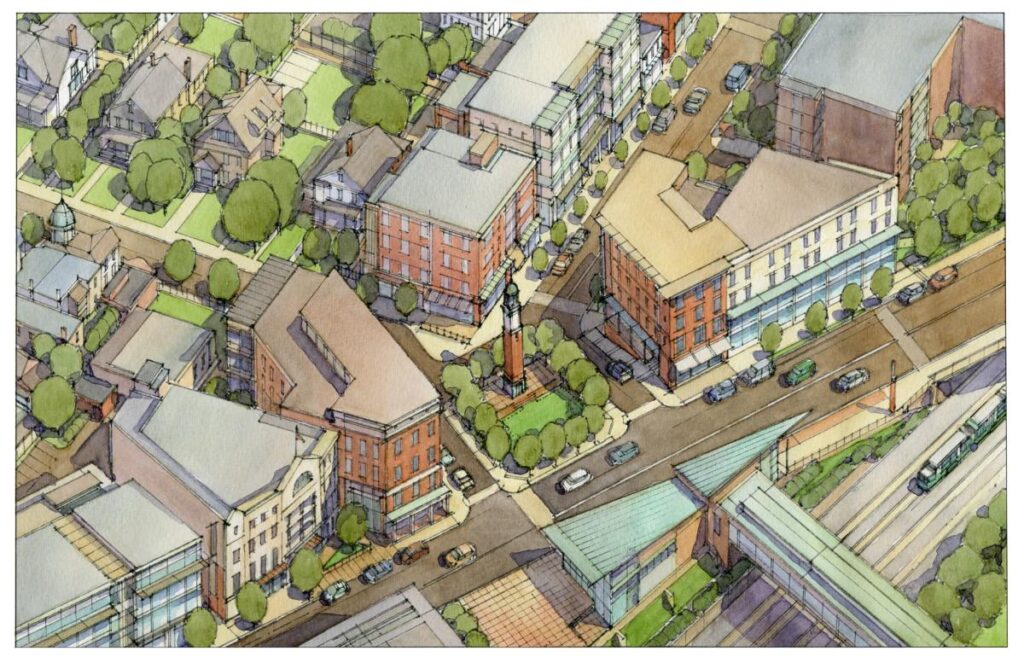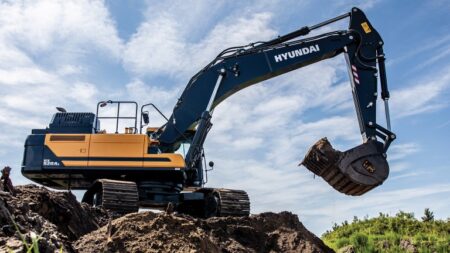Gilman Square Station Area Plan (City of Somerville rendering)
The Green Line Extension’s Medford branch in Somerville, Mass., has been open for nearly a year now, but a decade-old proposal to build hundreds of homes on a city-owned lot next to the new Gilman Square station remains unfulfilled.
Under the city of Somerville’s Gilman Square Station Area Plan, adopted in 2014, various empty lots at the corner of Medford and Pearl Streets were supposed to have been filled with new multi-story buildings and hundreds of new homes by now, in addition to new bike- and pedestrian-friendly streets and civic spaces.
Instead, the “square” is still a fenced-off field of gravel while various city agencies squabble for a stake in the empty land.
StreetsblogMASS reported Dec. 4 that during a city council hearing in November, Somerville officials revealed they wanted to wait another year to complete a “disposition study” before deciding to do anything with the property.
Christine Carlino, who lives nearby and serves as the board president of the Gilman Square Neighborhood Council, told StreetsblogMASS recently that the city’s lack of resolve is “incredibly disappointing.”
“Everybody knows we need transit-oriented development and affordable housing, and nobody’s actually making it happen,” she added. “It’s going to be hard to convince smaller cities and suburbs to build housing if the city of Somerville won’t do it on its own land.”
Housing Plans Delayed Longer Than Rail Extension
The city owns two key parcels next to the Gilman Square station. The larger of the two, the so-called “Homans site,” named for the warehouse building that existed there until Green Line construction demolished it in 2019, occupies a little less than 1 acre between Medford Street and the new Green Line station.
Somerville also owns a smaller triangular piece of land in the wedge between Pearl and Medford streets.
In 2019, the city adopted new zoning rules that legalize multi-story, mixed-use development up to six stories tall with limited off-street parking around Gilman Square.
Many of the site’s neighbors consider the empty lots an eyesore and want to see new development there.
Carlino estimates that the city-owned lots could hold at least 150 homes, a large proportion of which could be designated for lower-income households, plus ground-floor retail spaces for local small businesses. Further development of nearby privately-owned empty lots could add hundreds of additional homes.
Competing Municipal Interests Stall Development
At another council meeting earlier in the fall, Ward Four Councilor Jesse Clingan asked the city’s staff to explain the holdup.
“It’s a huge, missed opportunity that we have this space right on a transit node, while the state is urging communities to build housing around these stations, and right now there’s nothing happening down there,” said Clingan.
At a November economic development committee meeting, Ben Demers, an economic development planner for the city of Somerville, followed up with a presentation on the site’s history.
“This is one of the few city-owned lots of this size in this area, and this means that we need to weigh competing priorities for its use,” he explained.
For instance, city engineers had expressed interest in using the site to build a huge underground stormwater storage tank to mitigate flooding in Somerville’s aging sewer system.
Demers said that the city has since determined that installing a tank need not hold up redevelopment on the lot, “but it took us a while to get to that determination.”
Complicating matters, the nearby Winter Hill School abruptly closed in June after a chunk of concrete fell in an empty stairwell. Its classes have been relocated to temporary sites for the current school year, but some city officials would also like to keep the Homans parcel available as a possible longer-term solution.
“Because of these and other competing priorities, the city will complete a disposition study looking at all city-owned parcels and determining a priority for disposing and selling those sites,” Demers noted. “We expect that the Homans lot will rank highly.”
Later in the meeting, Rachel Nadkarni, Somerville’s director of economic development, revealed that the disposition study had not yet been started, and still needed to hire a new planner to manage the project. She estimated it would take another eight to 12 months to complete.
With that timeline, the city likely will not issue a call for development proposals for the site until 2025, and it would be several years after that before anything actually gets built.
Private Development, Streetscape Projects Delayed
The uncertainty around the city’s plans for the center of Gilman Square is also stalling development on privately-owned empty lots nearby, argued Carlino.
“Property owners and developers have approached [Gilman Square Neighborhood Council] for conversations and have expressed hesitation to develop until streetscape designs have been confirmed, curb cut locations are established, and traffic patterns have been established — all of which are being held up by the development of the Homans site,” she said at the November city council meeting.
Somerville municipal officials also have plans to rebuild and reconfigure Pearl and Medford Streets, directing through-traffic onto Pearl and possibly converting the Medford Street bridge over the Green Line into a car-free public space that would connect to the Somerville High School campus.
These plans, as well as a design for a possible new Medford Street entrance to the Green Line station, all hinge on the city deciding what to do with the Homans site.
Read the full article here











